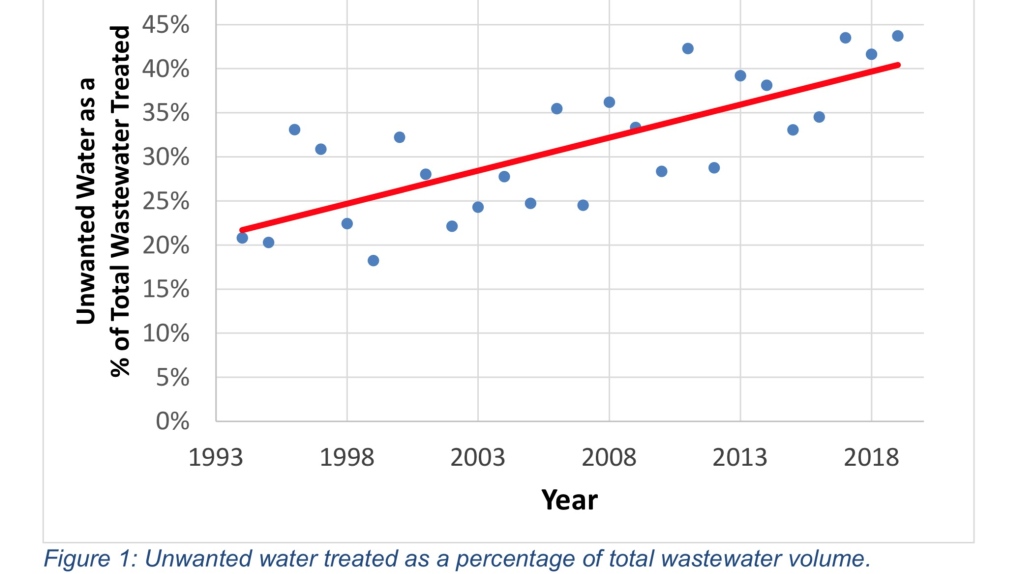The invisible problem flushing $1.4 million down the drain each year in London
Almost half of the water flowing into sewage treatment plants is being treated unnecessarily.
Dubbed “unwanted water” in a new report to city hall’s Civic Works Committee, stormwater that enters the sewer system is driving up treatment costs, flooding basements, and polluting the Thames River.
City engineers estimate that stormwater now constitutes 44 per cent of the volume in London’s sewers and pollution control plants.
The report suggests an investigation is needed to locate where stormwater is entering the wastewater system and develop solutions.
“The goals of (the) strategy are to both reduce the risk of basement flooding and reduce and eliminate sewage bypasses and overflows (into the river),” reads the report.
Sources of “unwanted water” include:
- Illegal Connections (1980-2021)
- Aging Pipes
- Weeping Tile & Downspout Connections
- Combined Sewers
“We know there is lots of raw sewage going into the Thames River during these extreme weather events,” explains Skylar Franke of the London Environmental Network. “So where is it coming from? I think it’s great that city staff are trying to figure this out and address it.”
The unwanted water increases the volumes treated at London’s pollution control plants, adding an estimated $1 million to operating costs each year.
It also adds about $400,000 to the utility costs to operate sewage pumping stations across the city.
Unwanted water takes a toll on many homeowners as well.
“It was 14 inches of water in the basement,” Mary Pilon recalls a severe sewage backup in her basement many years ago that destroyed precious items. “Going through your stuff to determine what has value is really hard. We lost out big time.”
Reducing the amount of stormwater infiltrating the sanitary sewer network of pipes will restore capacity and reduce backups into basements.
After their investigation determines the sources of unwanted water, city engineers will submit a business case to the next multi-year budget.
 A table showing unwanted water treated as a percentage of total wastewater volume. (Source: City of London)Franke, who has used a municipal program to secure her own basement from sewage incursions, believes incentives for homeowners will be a crucial component of the strategy.
A table showing unwanted water treated as a percentage of total wastewater volume. (Source: City of London)Franke, who has used a municipal program to secure her own basement from sewage incursions, believes incentives for homeowners will be a crucial component of the strategy.
“A lot of people don’t know that their weeping tiles may be connected into the sewer system, so once they figure it out, being able to provide support with financial incentives is a great motivator to disconnect them,” she said.
Pilon subsequently installed a backflow preventer and sump pump, and finally sleeps soundly on rainy nights.
“You don’t sleep, you tend to go down to the basement to check if it’s raining heavily. Not that there is anything you can do if it was coming up,” she said.
The report on unwanted water goes to council’s civic works committee on Dec. 14.
CTVNews.ca Top Stories

Trudeau's 2024: Did the PM become less popular this year?
Justin Trudeau’s numbers have been relatively steady this calendar year, but they've also been at their worst, according to tracking data from CTV News pollster Nik Nanos.
Back on air: John Vennavally-Rao on reclaiming his career while living with cancer
'In February, there was a time when I thought my career as a TV reporter was over,' CTV News reporter and anchor John Vennavally-Rao writes.
The winter solstice is here, the Northern Hemisphere's darkest day
The winter solstice is Saturday, bringing the shortest day and longest night of the year to the Northern Hemisphere — ideal conditions for holiday lights and warm blankets.
What we know about the suspect behind the German Christmas market attack
Germany on Saturday was still in shock and struggling to understand the suspect behind the attack in the city of Magdeburg.
Poilievre writes to GG calling for House recall, confidence vote after Singh declares he's ready to bring Liberals down
Conservative Leader Pierre Poilievre has written to Gov. Gen. Mary Simon, imploring her to 'use your authority to inform the prime minister that he must' recall the House of Commons so a non-confidence vote can be held. This move comes in light of NDP Leader Jagmeet Singh publishing a letter stating his caucus 'will vote to bring this government down' sometime in 2025.
School custodian stages surprise for Kitchener, Ont. students ahead of holiday break
He’s no Elf on the Shelf, but maybe closer to Ward of the Board.
Kelly Clarkson's subtle yet satisfying message to anyone single this Christmas
The singer and daytime-talk show host released a fireside video to accompany her 2021 holiday album, “When Christmas Comes Around” that she dubbed, “When Christmas Comes Around…Again.
Judge sentences Quebecer convicted of triple murder who shows 'no remorse'
A Quebecer convicted in a triple murder on Montreal's South Shore has been sentenced to life in prison without chance of parole for 20 years in the second-degree death of Synthia Bussieres.
16-year-old German exchange student dies after North Vancouver crash
A 16-year-old high school student from Germany who was hit by a Jeep in North Vancouver, B.C., last weekend has died in hospital, authorities confirmed.

































